Sanyo Electric Co SCP-25H Cellular/ PCS CDMA Phone with Bluetooth User Manual Key Functions
Sanyo Electric Co Ltd Cellular/ PCS CDMA Phone with Bluetooth Key Functions
Users Manual

SCP-2500
Operating Guide
(Draft)
Getting to Know Your Phone ................................................................................................5
Front View of Phone................................................................................................................5
Key Functions .........................................................................................................................6
Viewing the Display Screen.....................................................................................................7
Turning Your Phone On and Off..............................................................................................8
Unlocking the Phone ...............................................................................................................8
Using the Battery.....................................................................................................................8
Displaying Your Phone Number..............................................................................................9
Making and Answering Calls ..............................................................................................10
Making Calls..........................................................................................................................10
Dialing Options......................................................................................................................10
Answering Calls ....................................................................................................................10
Using the Speakerphone.......................................................................................................11
Changing the Ringer Volume ................................................................................................11
Adjusting Volume During a Conversation..............................................................................11
Missed Call Notification.........................................................................................................12
Calling Emergency Numbers.................................................................................................12
In-Call Options ......................................................................................................................12
End-of-Call Options...............................................................................................................12
Saving a Phone Number .......................................................................................................13
Finding a Phone Number ......................................................................................................13
Dialing and Saving Phone Numbers With Pauses ................................................................13
Using Abbreviated Dialing.....................................................................................................14
Dialing From the Contacts Directory .....................................................................................14
Using Speed Dialing..............................................................................................................14
Entering Text ......................................................................................................................15
Selecting a Character Input Mode.........................................................................................15
Entering Characters Using T9 Text Input ..............................................................................15
Adding a Word to the T9 Database.......................................................................................15
Entering Characters by Using Alphabet Mode ......................................................................15
Entering Numbers, Symbols, Preset Suffix and Smileys.......................................................16
Controlling Your Phone’s Settings......................................................................................17
Sound Settings......................................................................................................................17
Ringer Types.........................................................................................................................17
Selecting Ringer Types for Incoming Calls ...........................................................................17
Selecting Ringer Types for Voicemail or Calendar/Alarm .....................................................17
Selecting Ringer Types for Messaging..................................................................................17
Setting Tone Length, Start-up/Power-off Tone or Voice Prompt ...........................................17
Adjusting the Phone’s Ringer Volume...................................................................................17
Alert Notification....................................................................................................................18
Silence All .............................................................................................................................18
Display Settings ....................................................................................................................18
Changing the Text Greeting ..................................................................................................18
Changing the Backlight Time Length ....................................................................................19
Changing the Display Screen Animation...............................................................................19
Changing the Display for Incoming Calls ..............................................................................19
Changing the Clock/Calendar Display for the Standby Mode................................................19
Changing the Background.....................................................................................................20
Changing the Phone’s Main Menu Style ...............................................................................20
Changing the Font Size.........................................................................................................20
1
Location Settings...................................................................................................................20
Airplane Mode.......................................................................................................................20
TTY Use With PCS Service...................................................................................................21
Phone Setup Options............................................................................................................21
My Favorites..........................................................................................................................21
Auto Answer Mode................................................................................................................21
Setting the Open/Close Flip Options.....................................................................................21
Setting Any Key Answer........................................................................................................22
Setting Abbreviated Dialing...................................................................................................22
Headset Mode.......................................................................................................................23
Sleep Mode...........................................................................................................................23
Setting Message Notification.................................................................................................23
Editing Preset Messages.......................................................................................................23
Setting a Callback Number....................................................................................................23
Changing the Menu Language..............................................................................................23
Setting Your Phone’s Security............................................................................................24
Accessing the Security Menu................................................................................................24
Locking Your Phone..............................................................................................................24
Unlocking Your Phone ..........................................................................................................24
Changing the Lock Code.......................................................................................................24
Calling in Lock Mode.............................................................................................................24
Restricting Calls ....................................................................................................................25
Using Special Numbers.........................................................................................................25
Erasing the Contacts Directory..............................................................................................25
Erasing All My Content..........................................................................................................25
Resetting Your Phone ...........................................................................................................26
Controlling Your Roaming Experience................................................................................26
Understanding Roaming .......................................................................................................26
Setting Your Phone’s Roam Mode........................................................................................26
Using Call Guard...................................................................................................................26
Navigating Through Menus.................................................................................................27
Menu Navigation ...................................................................................................................27
Menu Structure......................................................................................................................27
Managing Call History.........................................................................................................28
Viewing History .....................................................................................................................28
Call History Options ..............................................................................................................28
Making a Call from Call History.............................................................................................28
Saving a Phone Number From Call History...........................................................................28
Prepending a Phone Number From Call History ...................................................................29
Erasing Call History...............................................................................................................29
Using the Contacts Directory..............................................................................................30
Adding a New Contacts List Entry.........................................................................................30
Finding Contacts Entries .......................................................................................................30
Contacts List Entry Options...................................................................................................30
Adding a Phone Number or Email Address to a Contacts Entry ...........................................31
Editing an Contacts Entry......................................................................................................31
Setting Speed Dial Numbers.................................................................................................31
Selecting a Ringer Type for an Entry ....................................................................................32
Secret Contacts Entries ........................................................................................................32
Dialing PCS Services ............................................................................................................32
2
Personal Organizer.............................................................................................................33
Managing the Calendar.........................................................................................................33
Adding an Event to the Calendar ..........................................................................................33
Event Alerts...........................................................................................................................34
Event Alert Menu...................................................................................................................34
Viewing the Event List...........................................................................................................34
Going to a Specified Date .....................................................................................................35
Erasing a Days Events..........................................................................................................35
Purging All Events.................................................................................................................35
Displaying Your User Address ..............................................................................................35
Finding Icon Definitions.........................................................................................................35
Displaying the Version Information........................................................................................35
Displaying Advanced Information..........................................................................................35
Using Your Phone’s Tools ..................................................................................................36
Using the Alarm Clock...........................................................................................................36
Using the Calculator..............................................................................................................36
Using the World Clock...........................................................................................................36
Using Your Phone’s Voice Services ...................................................................................37
Using Voice Memos ..............................................................................................................37
Reviewing Voice Memos.......................................................................................................37
Erasing Voice Memos ...........................................................................................................37
Setting Up Screen Call..........................................................................................................37
Selecting Announcement for Screen Call..............................................................................38
Recording Your Name for a Pre-Recorded Announcement ..................................................38
Recording a Customized Announcement..............................................................................38
Reviewing an Announcement................................................................................................38
Erasing an Announcement....................................................................................................38
Using Bluetooth ..................................................................................................................39
Turning Bluetooth On and Off ...............................................................................................39
Using the Bluetooth Settings Menu.......................................................................................39
Bluetooth Profiles..................................................................................................................40
Pairing Bluetooth Devices .....................................................................................................40
Sending Data via Bluetooth...................................................................................................41
Using Voicemail..................................................................................................................42
Setting Up Your Voicemail ....................................................................................................42
Voicemail Notification............................................................................................................42
New Voicemail Message Alerts.............................................................................................42
Retrieving Your Voicemail Messages....................................................................................42
Voicemail Options .................................................................................................................43
Clearing the Message Icon....................................................................................................44
Using Caller ID......................................................................................................................44
Responding to Call Waiting...................................................................................................45
Making a Three-Way Call......................................................................................................45
Using Call Forwarding...........................................................................................................45
Using SMS Text Messaging ..................................................................................................46
New Messages......................................................................................................................46
Composing SMS Text Messaging.........................................................................................46
Displaying Messages ............................................................................................................46
Safety..................................................................................................................................47
General Precautions .............................................................................................................47
3
Maintaining Safe Use of and Access to Your Phone.............................................................47
Caring for the Battery............................................................................................................48
Radiofrequency (RF) Energy.................................................................................................49
Specific Absorption Rate (SAR) for Wireless Phones ...........................................................49
FCC Notice .........................................................................................................................50
4
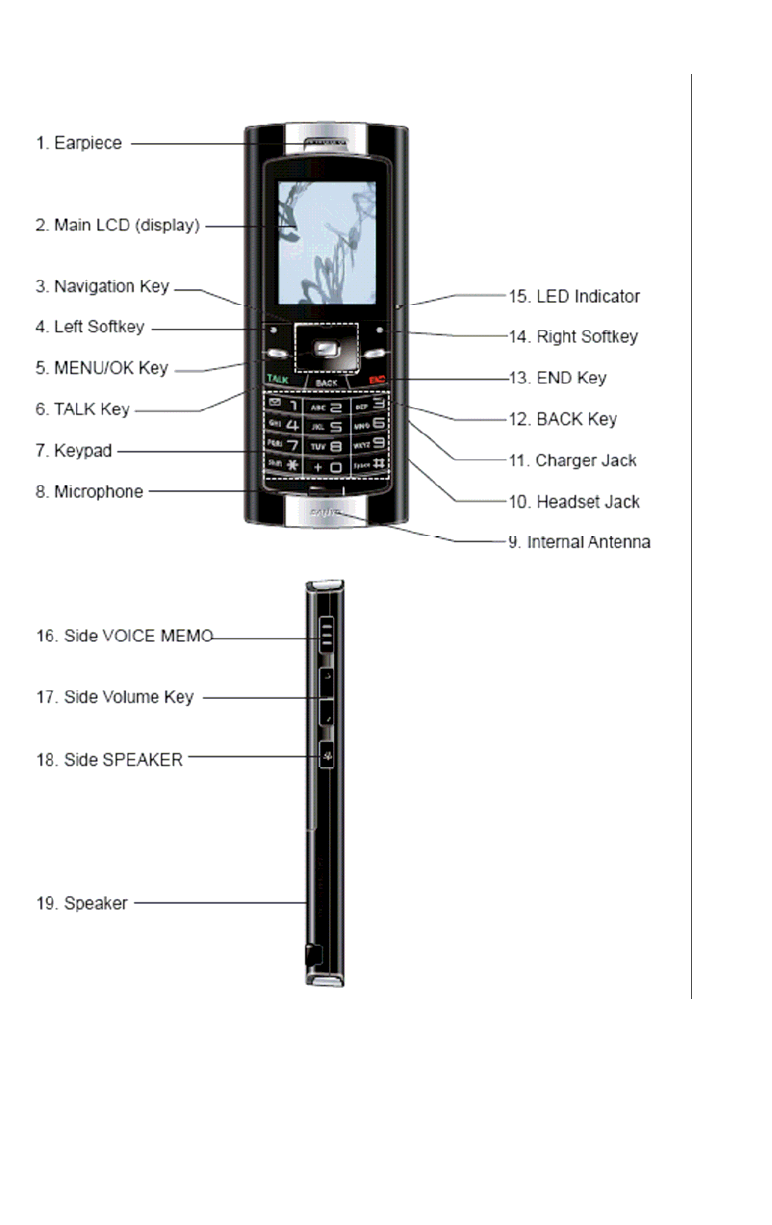
Getting to Know Your Phone
Front View of Phone
5
Key Functions
Key Functions
1. Earpiece lets you hear the caller’s voice.
2. Main LCD (display) displays the phone’s main menu, features, modes, etc.
3. Navigation key lets you navigate quickly and easily through the menu options and access
the shortcut menus.
4. Left Softkey lets you select the menu corresponding to the bottom left line on the Main LCD.
5. MENU/OK Key lets you access the phone’s menus and select menu options.
6. TALK Key lets you place or receive calls, answer Call Waiting, or use Three-Way Calling
and Voice Dial.
7. Keypad lets you enter numbers, letters, and characters, and navigate within menus. Press
and hold keys 2-9 for speed dialing.
8. Microphone to speak into or record your voice.
9. Internal Antenna facilitates reception and transmission. To maximize performance, do not
touch while using the phone.
10. Headset Jack lets you insert the plug of a headset (sold separately) for hands-free phone
use.
11. Charger Jack connects the Travel Charger.
12. BACK Key lets you clear characters from the screen or display the previous page.
13. END/POWER Key lets you turn the phone on/off, end a call, or return to standby mode.
14. Right Softkey lets you select the menu corresponding to the bottom right line on the
Main LCD.
15. LED Indicator shows your phone’s connection status at a glance.
16. Side VOICE MEMO allows you to access the Voice Memo menu.
17. Side Volume Key allows you to adjust the ringer volume in standby mode (with the phone
open) or adjust the voice volume during a call. Press and hold to make a voice dial or redial
with the phone closed.
18. Side SPEAKER Key lets you place or receive calls in speakerphone mode.
19. Speaker allows you hands-free conversation while in speakerphone mode.
6

Viewing the Display Screen
This list identifies some of the more common symbols you’ll see on your display screen.
• shows your current signal strength. The more lines you have, the stronger your signal.
• means your phone cannot find a signal.
• tells you a call is in progress.
• indicates the Vision services is dormant.
• Indicates the Vision services is active.
• indicates the Vision services is disabled.
• indicates the phone is on another service provider’s network.
• indicates you have missed voice calls.
• indicates you have schedule event and call alarm notifications.
• indicates you have messages waiting.
• shows the level of your battery charge. The more black you see, the more power you
have left.
• indicates the vibrate feature is set.
• indicates the voice call ringer setting is off.
• indicates the Location Service of your phone is enabled.
•
indicates the Location Service of your phone is disabled.
• indicates you have new caller’s message.
• indicates the Screen Call Auto setting is on.
• indicates TTY mode is set to on when you connect TTY devices.
• indicates the alarm clock is set to on.
• indicates the speakerphone mode is set to on.
• indicates headset is connected.
• indicates the Bluetooth feature is active.
7
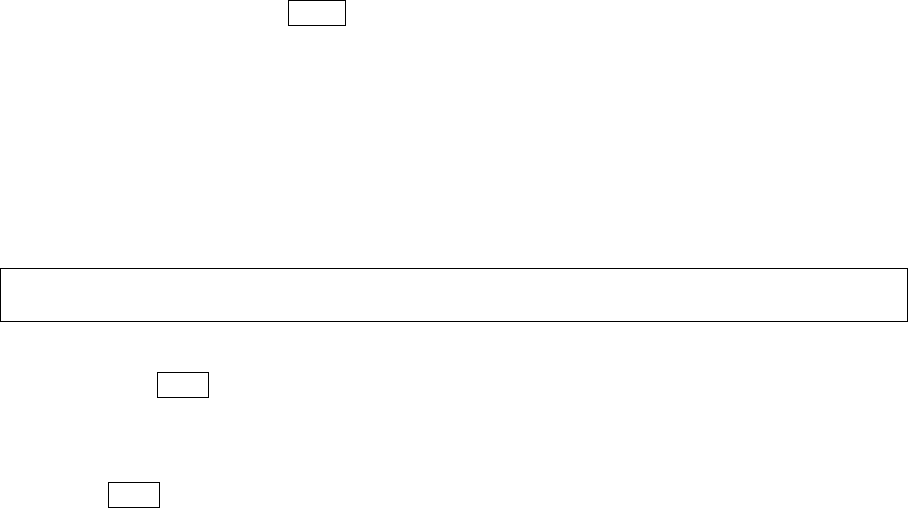
Softkeys
You can select the menus, which are described at the bottom line of the display by pressing the
corresponding softkeys (left/right). In this User Manual, the explanation for selecting such
menus are as shown below:
• Press Contacts(right softkey).
Turning Your Phone On and Off
Turning Your Phone On:
To turn your phone on, press END/ .
Once your phone is On, it displays “Looking for service...”, indicating that your phone is
searching for a signal. When your phone finds a signal, it automatically enters standby mode
–the phone’s idle state. At this point, you are ready to begin making and receiving calls. If your
phone is unable to find a signal after 15 minutes of searching, a Power Save feature is
automatically activated. When a signal is found, your phone automatically returns to standby
mode.
In power save mode, your phone searches for a signal periodically without your intervention.
You can also initiate a search for PCS Service by pressing any key (when your phone is turned
on).
Tip: The Power Save feature helps to conserve your battery power when you are in an area
where there is no signal.
Turning Your Phone Off:
Press and hold END/ for two seconds until you see the powering down animation on the display
screen. Your screen remains blank while your phone is off (unless the battery is charging).
Unlocking the Phone
1. Press END/ to turn the phone on.
2. Press Unlock (left softkey).
3. Enter your four-digit lock code. For security purposes, the code is not visible as you type.
Using the Battery
Installing the Battery
To install the Li-Ion battery:
-To install, insert the battery into the opening on the back of the phone and gently press down
until the latch snaps into place.
Removing the Battery
To remove your battery:
1. Make sure the power is off so that you don’ t lose any stored numbers or messages.
2. Press the battery release latch down and remove the battery from the phone at a
45-degree angle.
8
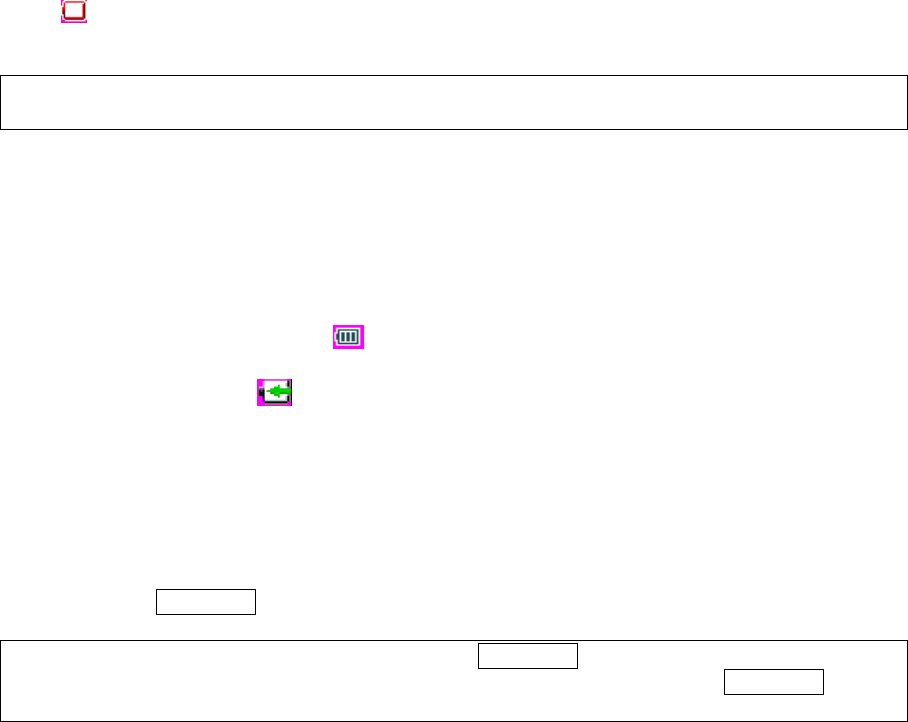
Charging the Battery
Your PCS Phone comes with a rechargeable battery. You should charge the battery as soon as
possible so you can begin using your phone.
Keeping track of your battery’s charge is important. If your battery level becomes too low, your
phone automatically turns off and you’ll lose all the information you were just working on. For a
quick check of your phone’s battery level, glance at the battery charge indicator located in the
upper-right corner of your phone’s display screen. If the battery charge gets too low, the battery
icon appears and the phone sounds a warning tone.
Always use a recommended Travel Charger or Vehicle Power Adapter to charge your battery.
Warning! Using the wrong battery charger could cause damage to your phone and void the
warranty.
Using the Travel Charger
To use the travel charger provided with your phone:
1. Plug the travel charger into a wall outlet.
2. Plug the other end into the travel charger into the charger jack on the side of your phone
(with the battery installed).
• Charging when your phone is turned on:
The battery icon animates while charging.
The battery icon turns to when charging is complete.
• Charging when your phone is turned off:
The battery icon appears, and the message “BATTERY CHARGING --Power
Off--” is shown on the display while charging. When the battery is completely
discharged, you may wait for several minutes until the message is shown on the
display. The battery icon turns to , and message changes to “CHARGING
COMPLETE --Power Off--” when charging is complete.
Displaying Your Phone Number
To display your phone number:
• Press MENU/OK > Contacts > My Name Card.
Note: To access the phone’s main menu, press MENU/OK from standby mode. Menu items
may be selected by highlighting them with the navigation key and pressing MENU/OK, or you
can press the number corresponding to the menu item on your keypad.
9

Making and Answering Calls
Making Calls
1. Make sure your phone is on.
2. Enter a phone number. (If you make a mistake while dialing, press BACK to erase one digit
at a time. Press and hold BACK to erase the entire number.)
3. Press TALK. (To make a call when you are roaming and Call Guard is enabled, press
Options (right softkey) > Roam Call or Roam:Speaker On.) When you’re finished, press
END/ to end the call.
Dialing Options
Dialing options are displayed when you press Options (right softkey) after entering numbers in
the standby mode.
To select an option, select it and press MENU/OK.
• Call to dial the phone number. (If you are roaming and have the Call Guard feature
activated, you need take extra step. See page 27 for setting Call Guard.)
• Call:Speaker On to dial the phone number in speakerphone mode.(If you are roaming and
have the Call Guard feature activated, you need take extra step. See page 27 for setting
Call Guard.)
• Send Message to send a text message.
• Save Phone# to save the phone number in your Contacts Directory. (See “Saving a Phone
Number” on page 13.)
• Find to display Contacts entries that end with the digits you enter. (See “Finding a Phone
Number” on page 13.)
• P Hard Pause to insert a hard pause. (See “Dialing and Saving Phone Numbers With
Pauses” on page 13.)
• T 2-Sec. Pause to insert a 2-second pause. (See “Dialing and Saving Phone Numbers
With Pauses” on page 13.)
• Hyphen to insert a hyphen manually where you like, however they are mainly for show.
(See “Dialing and Saving Phone Numbers With Pauses” on page 13.)
Tip: To speed dial a phone number from the standby mode, press and hold appropriate
speed dial key locations 2-9. See page 32 for setting.
This option appears when you press after entering 4-digit and press MENU/OK.
• Abbrev. Dial to dial the phone number in your Contacts list that ends with the four digits
you enter. (See “Using Abbreviated Dialing” on page 14.)
Answering Calls
1. Make sure your phone is on. If your phone is off, incoming calls go to voicemail.
2. When your phone rings, press TALK.
3. To disconnect the call, press END/.
Depending on your settings, your PCS Phone notifies you of incoming calls in the following
ways:
• The phone rings and/or vibrates.
• The LED flashes.
10

• The backlight illuminates.
• The screen displays an incoming call message.
• If available, the phone number of the caller is displayed.
• If the phone number is in your Contacts list, the Contacts entry’s name is displayed.
• The picture is displayed when you have set the downloaded picture to “Incoming Calls”.
The following options are also displayed by pressing Options (right softkey). To select an option,
highlight it and press MENU/OK.
• Call Guard to answer the call when you are in roaming. (This feature appears when you
are in digital area and analog service area.) See page 27 for setting Call Guard.
• Answer to answer the call.
• Answer:Speaker to answer the call in speakerphone mode.
• Answer on Hold to put the call on hold.
• Screen Call to answer the call by using pre-recorded announcement. (This feature
appears when you are in Service area or digital roaming area.) See page 38 for setting up.
• Quiet Ringer to mute the ringer. (This feature appears when the ringer is set.)
To answer a call when you are roaming and Call Guard is enabled, you must press Options
(right softkey), select Answer or Answer:Speaker and press MENU/OK to answer the call.
See page 27 for setting Call Guard.
Note: If your phone is off, the incoming calls go to voicemail.
Using the Speakerphone
The speakerphone feature lets you hear audio through the speaker and talk without holding the
phone. When the speakerphone is activated, use the Side Up/Down key to adjust the volume.
To turn the speakerphone on during a call:
Press SPEAKER.
-or-
Press Options (right softkey) > Speaker On.
To turn the speakerphone off during a call:
Press SPEAKER.
-or-
Press Options (right softkey) > Speaker Off.
Changing the Ringer Volume
To change the ringer volume, adjust the Side Up/Down key when the phone is open in standby
mode.
Note: To change the ringer volume from the main menu, see “Adjusting the Phone’s Ringer
Volume ” on page 17
Adjusting Volume During a Conversation
Whether you need to hear more or less of a conversation, adjust the Side Up/Down key, or
press the navigation key up or down during a call.
11

Missed Call Notification
When an incoming call is not answered, the Missed Call log is displayed on your screen.
To display the Missed Call entry:
Select MENU/OK > Missed Alerts.
To call the entry:
Highlight the entry you want to call and press TALK .
Calling Emergency Numbers
You can place calls to 911 (dial 9 1 1 and press TALK), even if your phone is locked or your
account is restricted. Once the dial is made, you will enter Emergency mode. The phone tries to
dial to 911 automatically until the dial will be connected. While you are in the Emergency mode,
all phone calls can be received.
To exit from the Emergency mode, follow these instructions:
1. Press END/ .
2. Press Options > Exit Emergency.
In-Call Options
During a call, your phone displays menu options by pressing Options (right softkey). To select
an option, highlight it and press MENU/OK.
• Flash to answer an incoming Call Waiting call or connect a third party during Three-Way
Calling.
• Mute or Unmute to mute or reactivate your phone’s microphone.
• Speaker On or Speaker Off to route the phone’s audio through the speaker. You can
adjust the speakerphone volume using the Side Up/Down key.
• Transfer Audio to switch the call to your desired device(if applicable).
• Three- Way Call to call a third party.
• Call History to access the Cal History menu. (See “Managing Call History” on page 29.)
• Contacts to access the Contacts menu. (See “Using the Contacts Directory” on page 31.)
• Messaging to access the Messaging menu.
• Settings to access the Settings menu. (See “Controlling Your Phone’s Settings” on page
17.)
• Tools to access the Tools menu.
Note: The Flash menu appears only for Call Waiting and Three-Way Calling. The Mute menu
does not appear during a 911 call. The Three-Way Call Menu does not appear in Roaming
areas.
End-of-Call Options
To display the following options, press Options (right softkey) within 10 seconds after
disconnecting a call.
To select an option, highlight it and press MENU/OK.
12

・ Call Again to dial the phone number.
・ Call: Speaker On to dial the phone number in speakerphone mode.
・ Save Phone# to save the phone number in your Contacts list. Go to Phone Book appears
when the number is already in your Contacts list. (See “Saving a Phone Number” below.)
・ Send Message to send a Text, Picture Mail, or Voice message.
Note: The End-of-Call options are not displayed for calls identified as No ID or Restricted.
Saving a Phone Number
Your PCS Phone can store a total of 700 phone numbers in 500 Contacts entries. Each entry
can store 7 phone numbers, and the entry’s name can contain 32 characters. Your phone
automatically sorts the Contacts entries alphabetically.
To save a number from the main menu:
1. Enter a phone number.
2. Press Options (right softkey) > Save Phone#.
3. Select the following entry modes:
• New Name to enter a name directly.
• From Ph. Book to select a name from Contacts entry list
(This step is not necessary on the very first entry in Contacts.)
4. Select a label and press MENU/OK.
5. Enter a name for the new entry using the keypad and press MENU/OK.
– or –
Search for an existing contact name and press to save the new number.
After you have saved the number, the new Contacts entry is displayed. (See “Contacts List
Entry Options” on page 31).
Finding a Phone Number
You can search Contacts entries for phone numbers that contain a specific string of numbers.
To find a phone number:
1. Enter the last four or more digits of the number. The more numbers you enter, the more
specific the search becomes.
2. Press Options (right softkey) > Find. (The Contacts entry that ends with the digits you
entered appears.)
3. To display the Contacts entry that contains the phone number you entered, highlight the
entry and press MENU/OK. To dial the number, press TALK.
Dialing and Saving Phone Numbers With Pauses
You can dial or save phone numbers with pauses for use with automated systems, such as
voicemail or credit card billing numbers. If you select a hard pause, the next set of numbers is
sent when you press TALK. If you select a 2-second pause, your phone automatically sends the
next set of numbers after two seconds.
Note: You can have multiple pauses in a phone number and combine 2-second and hard
pauses.
13

To dial or save phone numbers with pauses:
1. Enter the phone number and press Options (right softkey).
2. Select either Hard Pause or 2-Sec. Pause. Hard Pauses are displayed as a “P” and
2-second pauses as a “T”.
3. Enter additional numbers.
4. To dial the number, press TALK . (When dialing a number with a hard pause, press TALK
to send the next set of numbers.)
or -
To save the number in your Contacts list, press Options (right softkey) > Save Phone#,.
Using Abbreviated Dialing
Abbreviated Dialing is similar to speed dialing. It allows you to dial a number by entering the last
four or five digits of any number in your Contacts directory. This feature becomes available
when you enable Abbreviated Dialing and program a five-or six- digit prefix you wish to use for
abbreviated dialing. (See “Setting Abbreviated Dialing” on page 22.)
To place a call using Abbreviated Dialing:
1. Enter the last four or five digits of the prefix phone number.
2. Press TALK.
Note: If there are more than two matched numbers in your Contacts list, the Abbrev. Dial list will
be displayed; select the correct entry and press TALK again. If there is no matched number,
your phone dials the number you set for abbreviated dial with the last 4-digits you entered.
Dialing From the Contacts Directory
1. Select MENU/OK > Contacts > Find/Add Entry.
Shortcut: Press the navigation key right to list entries.
2. Use your navigation key to scroll through the Contacts list, highlight your desired entry, and
press MENU/OK.
3. Highlight the number you want to call.
4. Press Options (right softkey)> Call or Call:Speaker On.
Tip: You can also make a call by pressing TALK during step 4 above.
Using Speed Dialing
With this feature, you can dial your favorite entries using one key press for location 2-9.
To use speed dial for voice calls:
From standby mode, press and hold the appropriate key for approximately two seconds.
- or -
From standby mode, press the appropriate key and press TALK.
14

Entering Text
Selecting a Character Input Mode
Your PCS Phone provides convenient ways to enter words, letters, punctuation, and numbers
whenever you are prompted to enter text (for example, when adding an Contacts List entry).
To change the character input mode:
1. When you display a screen where you can enter text, press Mode (right softkey).
2. To select a character input mode, highlight it and press MENU/OK.
Entering Characters Using T9 Text Input
T9 Text Input lets you enter text in your PCS Phone by pressing keys just once per letter. (To
select the T9 Word mode when entering text, see “Selecting a Character Input Mode” above.)
T9 Text Input analyzes the letters you enter using an intuitive word database and creates a
suitable word. (The word may change as you type.) To accept a word and insert a space, press
Space #.If you make a mistake, press BACK to erase a single character. Press and hold BACK
to delete an entire entry.
Adding a Word to the T9 Database
If a word you want to enter does not display as an option when you are using T9 Text Input, you
can add it to the database.
To add a word to the database:
1. Select the Add Word input mode.
2. Enter the word using multi-tap text entry. (See “Entering Characters by Using Alphabet
Mode” described below.)
3. Press Save (left softkey). The word will appear as an option the next time you scroll
through options during T9 Text Input.
Entering Characters by Using Alphabet Mode
To enter characters by tapping the keypad, select the Alphabet mode (see “Selecting a
Character Input Mode” above). Press the corresponding key until the desired character appears.
By default, the first letter of a word is capitalized and following letters are lowercase.
Characters scroll in the following order:
English Sequence
Key Upper Case Lower Case
1 . , @ 1 ? ! * # /
2 ABC2 abc2
3 DEF3 def3
4 GHI4 ghi4
5 JKL5 jkl5
6 MNO6 mno6
7 PQRS7 pqrs7
8 TUV8 tuv8
9 WXYZ9 wxyz9
0 0
# Space
* Unshifted One-character-shifted Caps Lock
15

Entering Numbers, Symbols, Preset Suffix and Smileys
Entering SYMBOLS
To enter symbols:
1. In a text entry field, press Mode (right softkey).
2. Select SYMBOL and press MENU/OK.
3. Select the line that includes your desired symbol.
4. Press the corresponding key (1 ~ 8) with each symbol.
-or-
Select your desired symbol by using the navigation key, and press MENU/OK.
Entering NUMBERS
To enter numbers:
1. In a text entry field, press Mode (right softkey).
2. Select NUMBER and press MENU/OK.
3. Press the corresponding numeric key to enter the number.
Shortcut: Press and hold the corresponding number key to enter the number directory in
alphabet mode or T9 mode.
Entering PRESET SUFFIXES
To enter preset suffixes:
1. In a text entry field, press Mode (right softkey).
2. Select PRESET SUFFIX and press MENU/OK.
3. Select your desired word by using the navigation key and press MENU/OK.
Entering SMILEYS
To enter smile pictures (“emoticons”)
1. In a text entry field, press Mode (right softkey).
2. Select SMILEYS
3. Select the line that includes your desired smiley.
4. Press the corresponding key (1~4) with each smiley.
-or-
Select your desired smiley by using the navigation key and press MENU/OK.
Tip: When you see triangles on the left and right of the menu, you can press the navigation key
left or right to switch between different input modes.
16

Controlling Your Phone’s Settings
Sound Settings
Ringer Types
Ringer types help you identify incoming calls and messages. You can assign ringer types to
individual Contacts entries, types of calls and types of messages.
● Programmed Ringers include a variety of standard ringer types and familiar music.
● Vibrating Ringer alerts you to call or messages without disturbing others.
● Downloaded Ringers can be downloaded right to your phone.
Selecting Ringer Types for Incoming Calls
Your PCS Phone provides a variety of ringer options, which allow you to customize your ringer
and volume settings.
To select a ringer type for voice calls so you recognize when a certain type of call is coming in
by the ringer:
1. Select MENU/OK > Settings > Sounds > Ringer Type > Incoming Calls.
2. Select the menu under With Caller ID, No Caller ID or Roaming.
3. Select your desired ringer type and press MENU/OK.
Selecting Ringer Types for Voicemail or Calendar/Alarm
To select a ringer type for voicemail:
1. Select MENU/OK > Settings > Sounds > Ringer Type.
2. Select Voicemail or Calendar/Alarm.
3. Select your desired ringer type and press MENU/OK.
Selecting Ringer Types for Messaging
To select a ringer type for text messages:
1. Select MENU/OK > Settings > Sounds > Ringer Type.
2. Select Messaging.
3. Select your desired ringer type and press MENU/OK.
Setting Tone Length, Start-up/Power-off Tone or Voice Prompt
You can determine the length of your key beep (you hear this when you press any key) or type
of the Start-up/Power off tone (sounds when you turn the phone on/off on this feature).
1. Select MENU/OK > Settings > Sounds > Others.
2. Select Tone Length, Start-up Tone, Power-off Tone, Voice Prompt or Key Press Echo.
3. Select your desired option and press MENU/OK.
Adjusting the Phone’s Ringer Volume
To change the ringer volume:
1. Select MENU/OK > Settings > Sounds > Volume > Ringer
2. Using your navigation key, select your desired volume level and press MENU/OK.
17

To adjust Earpiece or Speaker volume:
1. Select MENU/OK > Settings > Sounds > Volume > Receiver.
2. Select Earpiece or Speaker.
3. Using your navigation key, select your desired volume level and press MENU/OK.
Tip: You can adjust the ringer volume in standby mode by using the Side Up/Down key, and
adjust earpiece volume during a call by using the navigation key up or down.
Tip: When ringer volume is set to Silence All, voice prompts cannot be heard.
Alert Notification
Your phone comes with several different options to keep you aware of what’s going on by
sounding the alert or ringer.
• Service sets alert On or Off for network services parameter changes.
• Voicemail sets alert to notify you of caller’s messages.
• Messaging sets alert to notify you of text messages.
• Minute Beep sets a minute reminder that beeps ten seconds before the end of each
minute during a call.
• Signal Fade sets alert to notify you when your phone loses a signal during a call.
To set the alerts:
1. Select MENU/OK > Settings > Sounds > Alerts.
2. Select your desired option and press MENU/OK.
Tip: Repeat Alert sounds every two minutes for twenty minutes.
Silence All
There may be times when you need to silence your phone entirely. The phone’s Silence All
option allows you to mute all sounds without turning your phone off:
To activate Silence All:
> With the phone open, press and hold the Up/Down key down in standby mode. (The screen
will display “Silence All.”)
To deactivate Silence All:
> Press the Side Up/Down key up repeatedly to select a desired volume level
Display Settings
Changing the Text Greeting
The text greeting can be up to 15 characters and is displayed on your phone’s screen in
standby mode. You may choose to display a custom greeting or default greeting.
To display or change your custom greeting:
1. Select MENU/OK > Settings > Display > Greeting > Custom.
2. Enter a custom greeting using your keypad and press MENU/OK.
18

Changing the Backlight Time Length
The backlight setting lets you select how long the display screen and keypad are backlit after
any key press is made.
To change the Main LCD backlight setting:
1. Select MENU/OK > Settings > Display > Backlight.
2. Select Main LCD.
3. Select Always On, Always Off or a preset length of time.
• Always Off always turns the Backlight off.
• Always On keeps the backlight on indefinitely.
Note: The Always On setting returns to previous value on next time you turn on the phone.
To change the Keypad backlight setting:
1. Select Key during previous step 2, and press MENU/OK.
2. Select Always Off or a preset length of time.
Note: Long backlight setting affects the battery’s talk and standby times.
Changing the Display Screen Animation
Your new PCS Phone offers animation for what you see on the display screen during standby
mode, Outgoing Calls, or Service Search.
To assign the animation:
1. Select MENU/OK > Settings > Display > Animation.
2. Select Standby, Outgoing Calls or Service Search.
3. Select Set and then select an option and press MENU/OK.
4. Select an animation display and press MENU/OK.
Changing the Display for Incoming Calls
You can set the color or downloaded image (screen saver) data to be shown on the Incoming
Call display.
Follow these steps:
1. Select MENU/OK > Settings > Display > Incoming Calls.
2. Select an option and press MENU/OK.
3. Select your desired color or downloaded image (screen saver) and press MENU/OK.
Changing the Clock/Calendar Display for the Standby Mode
This feature enables you to select a variety of items to display in standby mode.
To set your standby display:
1. Select MENU/OK > Settings > Display > Clock/Calendar.
2. Select Main LCD.
3. Select your desired item and press MENU/OK.
4. Press OK to apply the clock display setting.
19

Changing the Background
You can customize your phone display’s appearance by selecting a color scheme to reflect
your personality.
To change the display’s background:
1. Select MENU/OK > Settings > Display > Background.
2. Select Main LCD.
3. Select your desired color and press MENU/OK.
Changing the Phone’s Main Menu Style
To select the display’s main menu style:
1. Select MENU/OK > Options(right softkey) > Change View.
2. Select an option and press MENU/OK.
Changing the Font Size
There are four font size settings for the message notification and browser. To change the font
size, follow these steps:
1. Select MENU/OK > Settings > Display > Others > Font Size.
2. Select View or Input.
• View to select Main LCD.
• Input to select from Phone#s, Messaging, or Others.
3. Select your desired font size and press MENU/OK.
Location Settings
To enable your phone’s Location feature:
1. Select MENU/OK > Settings > Location.
2. Read the disclaimer and press OK (left softkey).
3. Select On
• To deactivate this feature, select Off during step 2 above.
Tip: When the Location feature is on, your phone’s standby screen will display the icon.
When Location is turned off, the
icon will be displayed.
Airplane Mode
When your phone is in Airplane Mode, it cannot send or receive any calls (expect for 911
dialing) or access online information. You may still use the phone’s other features, such as
Games, Call Memos, Calendar, etc., while you are in Airplane Mode.
To set Airplane Mode:
1. Select MENU/OK > Settings > Others > Airplane Mode.
2. Read the message, and press or OK (left softkey).
Press Cancel (right softkey) to return to the previous menu.
3. Select On.
20

To deactivate this feature, select Off during step 3 above.
Note: While in Airplane mode, your phone’s standby screen will display “Phone Off“.
TTY Use With PCS Service
This feature set the TTY Mode to On or Off. A TTY (also known as TDD or Text Telephone) is a
telecommunications device that allows people who are deaf or hard of hearing, or who have
speech or language disabilities, to communicate by telephone. Connect the TTY device to the
Headset Jack of Your PCS Phone. Then, type the message you want to send on the TTY’s
keyboard.
To Turn the TTY Mode On or Off:
1. Select MENU/OK > Settings > Others > TTY.
2. You will see a message on the display. Press OK (left softkey) to continue.
3. Select Enable or Disable.
Phone Setup Options
My Favorites
You can arrange your own shortcut menu.
1. Press Favorites(left softkey).
2. Select <Add Favorite>.
3. Select an option and press MENU/OK.
4. Using the navigation key or your keypad, select functions to be assigned to the My
Favorites list.
5. Press Assign (left softkey) to save.
Auto Answer Mode
This feature sets the phone to automatically pick up after 5 or 15 seconds. This feature works
with the hands-free car kit and headset (sold separately).
To activate this feature:
1. Select MENU/OK > Settings > Others > Auto Answer.
2. Select Hands-free or Speakerphone and press MENU/OK.
3. Select either 5 Seconds or 15 Seconds and press MENU/OK.
To deactivate this feature, select Off during step 3 above.
Setting the Open/Close Flip Options
This feature enables you to answer an incoming call by opening the phone or to end a call by
closing the phone.
To activate the Open Flip feature:
1. Select MENU/OK > Settings > Others > Open/Close Flip > Open.
2. Select Answer Call.
To deactivate this feature, select No Action during step 2 above.
To activate the Close Flip feature:
1. Select MENU/OK > Settings > Others > Open/Close Flip > Close. (You will see a
message on the display.)
21

2. Press OK (left softkey) to continue.
3. Select an option from the following and press MENU/OK.
• End to end the call.
• Continue(Mute) to continue the call. Your voice is muted, however you can hear the
caller’s voice from the speaker.
• Continue(Unmute) to continue the call. You can hear the caller’s voice and speak to the
phone to answer.
Setting Any Key Answer
This feature allows you to answer incoming calls by pressing any key (except END, BACK,
softkeys, and side keys).
To activate this feature:
Select MENU/OK > Settings > Others > Any Key Answer > On.
• To deactivate this feature, select Off.
Setting Abbreviated Dialing
Abbreviated Dialing allows you to dial a number using the last four or five digits of the phone
number. You can use either of the following options for this feature:
• Ph. Book Match allows you to retrieve any number saved in your Contacts list by entering
the last three to six digits of the number.
• Prepend # allows you to predefine the first five- or six-digit prefix you wish to use for
abbreviated dialing, so that you can dial a number by entering only the last four or five digits
of the number.
To set Abbreviated Dialing:
1. Select MENU/OK > Settings > Others > Abbrev. Dial.
2. Select Ph. Book Match, and then select Enable or Disable.
3. Select Prepend, and then select Enable.
4. Select Prepend#, enter the first five- or six- digit prefix, and then select OK(left softkey).
• To deactivate this feature, select Disable during step 3 above.
Tip: If you enter less than 5 digits, the display shows a warning message.
22

Headset Mode
To set Headset mode:
1. Select MENU/OK > Settings > Others > Headset Mode > Turbo Button.
2. Select On or Off.
Press Info (right softkey) during step 2 above to see the Headset Mode information.
Sleep Mode
This feature helps conserve your battery power by restricting the display.
To set sleep mode:
1. Select MENU/OK > Settings > Others > Sleep Mode.
2. Select Main LCD.
3. Select your desired option and press MENU/OK.
To deactivate this feature, select Off during step 3 above.
Setting Message Notification
You can see message notification when you receive Text message or Voicemail while you are
in PCS applications or Browser mode.
1. Select MENU/OK > Settings > Messaging > Notification.
2. Select Msgs and Icon or Icon only.
Editing Preset Messages
Your phone can store pre-set messages for use with text messaging and Picture Mail. You can
edit your phone’s default preset messages through the Settings menu.
To edit your phone’s preset messages:
1. Select MENU/OK > Settings > Messaging > Preset Msgs.
2. Select the message you want to edit and press MENU/OK.
3. Use your keypad to edit the message and press OK (left softkey) or to save your changes.
Setting a Callback Number
With this feature, you can notify your recipients of your callback number with the text message.
To set the callback number:
1. Select MENU/OK > Settings > Messaging > Text > Send Callback#.
2. Select your desired option and press MENU/OK.
Changing the Menu Language
When you first turn your phone on, the menus are displayed in English.
To change the menu language to Spanish, follow these steps.
1. Select MENU/OK > Settings > Others > Language.
2. Select English or Español.
23

Setting Your Phone’s Security
Accessing the Security Menu
You must enter your lock code to view the Security menu.
To access the Security menu:
1. Select MENU/OK > Settings > Security.
2. Enter lock code.
Tip: If you can’t recall your lock code, try using the last four digits of either your Social Security
number or PCS Phone Number or try 0000.
Locking Your Phone
When your phone is locked, your phone allows you to restrict the incoming calls and make calls
except 911 and special numbers.
To lock your phone:
1. From the Security Menu display (See “Accessing the Security Menu” on this page), select
Lock Phone.
2. Select Lock Now or On Power-up.
3. Depending on your preference, select either Full Lock or Excep. IncomingCalls.
● Full Lock: All phone calls except for Emergency number or Special numbers cannot be
made. And no phone calls can be received except for Special numbers.
● Excep. Incoming Calls: All phone calls except for Emergency number or Special numbers
cannot be made. But all incoming calls can be received.
Tip: If you want to cancel the “On Power-up” setting before turning the phone off, select
Unlocked during step 2 above.
Unlocking Your Phone
To unlock your phone:
1. Press Unlock (left softkey).
2. Enter your lock code.
Changing the Lock Code
1. From the Security Menu display (See “Accessing the Security Menu” on this page), select
Others > Change Lock.
2. Enter and re-enter your new lock code.
Calling in Lock Mode
You can place calls to 911 and to your special numbers when in lock mode.
To call an Emergency number or special number, enter the phone number and press TALK .
(For Emergency numbers, see “Calling Emergency Numbers” on page 12).
24

Restricting Calls
You can restrict both incoming calls and outgoing calls if necessary. (The Restrict Calls setting
does not apply to 911).
To restrict calls:
1. From the Security Menu display (See “Accessing the Security Menu” on page 24),
2. Select Others and press MENU/OK.
3. Select Limit Use and press MENU/OK.
4. Select the menu under Outgoing Calls or Incoming Calls and press MENU/OK.
5. Select your desired option and press MENU/OK.
Options:
• Allow All: You can make or receive all calls.
• Phone Book Only: Only Contacts entries, Voicemail, or special numbers are available to
make or receive calls.
• Special #s Only: Only three special numbers’ entries are available to make or receive
calls.
Note: Restricted incoming calls are forwarded to voicemail.
Using Special Numbers
You can save three special numbers in addition to your Contacts list entries (the same number
may be in both directories). You can make and receive calls from special numbers even when
your phone is locked.
To add or replace a special number:
1. From the Security Menu display (See “Accessing the Security Menu” on page 24), select
Others > Special #s.
2. Select the box under the entry number and press MENU/OK.
3. Enter your desired phone number and press MENU/OK.
Erasing the Contacts Directory
To erase all the names and phone numbers in your Contacts Directory:
1. From the Security Menu display (See “Accessing the Security Menu” on page 24), select
Erase Ph. Book.
2. If you’re sure you want to erase your Contacts, select Yes.
Erasing All My Content
To erase all the downloaded data from web:
1. From the Security Menu display (See “Accessing the Security Menu” on page 24), select
Erase My Content.
2. If you’re sure you want to erase downloaded data from web, select Yes.
If you have assigned downloaded data, the function returns to its default setting.
25

Resetting Your Phone
Resetting the phone restores all the factory defaults, including the ringer types and display
settings. The Contacts list, Call History, Scheduler and Messages are not affected.
To reset your phone:
1. From the Security Menu display (See “Accessing the Security Menu” on page 24), select
Reset Phone.
2. If you’re sure you want to reset your phone, select Yes.
Controlling Your Roaming Experience
Understanding Roaming
Recognizing Icons on the Display Screen
Your phone’s display screen always lets you know when you’re off the Nationwide PCS Network.
Any time you are roaming, the phone displays the roaming icon.
Tip: Remember, when you are using your phone off the Nationwide PCS Network, always dial
numbers using 11 digits (1 + area code + number).
Note: You will pay a higher per-minute rate for roaming calls.
Roaming on Other Digital Networks
When you’re roaming on other digital networks, your call quality and security will be similar to
the quality you receive when making calls while on the Nationwide PCS Network. You may not
be able to access certain calling features.
Note: If you’re on a call when you leave the Nationwide PCS Network and enter an area where
roaming is available (whether digital or analog), your call is dropped. If your call is dropped in an
area where you think PCS Service is available, turn your phone off and on again to reconnect to
the Nationwide PCS Network.
Setting Your Phone’s Roam Mode
Your PCS Phone allows you to control your ability to roam. By using the Roaming menu option,
you can determine which signals your phone accepts.
Set Mode
Choose from three different settings on your phone to control your roaming experience:
1. Select MENU/OK > Settings > Others > Roaming > Set Mode.
2. Select an option and press MENU/OK.
Using Call Guard
Your phone has two ways of alerting you when you are roaming off the PCS Network: the
onscreen roaming icon and Call Guard. Call Guard makes it easy to manage your roaming
charges by requiring an extra step before you can place or answer a roaming call
.
To Turn the Call Guard On or Off:
1. Select MENU/OK > Settings > Others > Roaming > Call Guard.
2. Select On or Off.
To Place Roaming Calls With Call Guard On:
26

1. From standby mode, dial 1 + area code + the seven-digit number. (You can also initiate a
call from the Contacts directory, Call History, or Messaging.)
2. Press TALK (or press Options (right softkey), highlight Call or Call:Speaker On) and
press MENU/OK.
3. Press 1 to proceed while the pop-up message is displayed.
-or
Press any key to erase the pop-up message, and then press Options (right softkey) >
Roam Call or Roam:Speaker On.
To Answer Incoming Roaming Calls With Call Guard On:
1. Press TALK .
2. Press 1 to proceed while the pop-up message is displayed.
-or-
Press Options (right softkey) >Answer or Answer:Speaker.
Remember if the Call Guard feature is set to On, you need to take extra steps to make and
receive roaming calls.
Navigating Through Menus
Menu Navigation
The navigation key on your PCS Phone allows you to scroll through menus quickly and easily.
To scroll bar at the right of the menu keeps track of your position in the menu at all times. To
navigate through a menu, simply press the navigation key up or down.
Menu Structure
Selecting Menu Items
As you navigate through a menu, the options are highlighted. Select an option by highlighting it
and pressing MENU/OK.
For example, if you want to view your last incoming call:
1. Press MENU/OK to access the main menu.
2. Select Call History and press MENU/OK. (It may already be highlighted).
3. Press the navigation key down to highlight Incoming Calls and press MENU/OK.
If you have received any calls, they are displayed on the screen.
Note: You may also select numbered menu items by pressing the corresponding number on
your keypad.
Backing Up Within a Menu
• To go to the previous menu:
Press Back.
• To return to standby mode:
Press END/.
27

Managing Call History
Viewing History
You’ll find the Call History feature very helpful. It is a list of the last 20 phone numbers (or
Contacts entries) for calls you placed, accepted, or missed. Call History makes redialing a
number fast and easy. It is continually updated as new numbers are added to the beginning of
the list and the oldest entries are removed from the bottom of the list.
To view a Call History entry:
1. Select MENU/OK > Call History.
2. Select Outgoing, Incoming, Missed or Recent Calls.
3. Highlight the entry you wish to view and press MENU/OK.
Call History Options
For additional information options on a particular call, highlight a Call History entry and press
Options (right softkey).
• Call to dial the phone number.
• Call:Speaker On to dial the phone number in speakerphone mode.
• Send Message to send a Text or Picture Mail message.
• Save Phone# to save the phone number (if applicable). If the caller’s phone number is
already saved in your Contacts list, Go to Phone Book appears. (See “Saving a Phone
Number From Call History” below )
• Prepend to add numbers to the beginning of the phone number. (See “Prepending a
Phone Number From Call History” on page 30.)
• Erase to erase the entry.
Making a Call from Call History
To place a call from Call History:
1. Select MENU/OK > Call History.
2. Select Outgoing, Incoming, Missed or Recent Calls.
3. Select the entry you want to call by scrolling through the list.
4. Press TALK .
-or-
Press Options (right softkey) > Call or Call:Speaker On.
Note: You cannot make calls from Call History to entries identified as No ID or Restricted.
Saving a Phone Number From Call History
Your PCS Phone can store up to 500 Contacts entries. Contacts entries can store up to a total
of 700 phone numbers and each entry’s name can contain 32 characters.
To save a phone number from Call History to your Contacts list:
After you have saved the number, the new Contacts entry is displayed. (See “Contacts List
Entry Options” on page 31).
1. Select the Call History entry you want to save.
2. Press Options (right softkey) > Save Phone#
28

3. Select the following entry modes:
New Name to enter a name directly.
From Ph. Book to select a name from Contacts entry list
(This step is not necessary on the very first entry in Contacts.)
4. Select a label and press MENU/OK.
5. Enter a name for the new entry using the keypad and press MENU/OK.
– or –
Search for an existing contact name and press to save the new number.
6. Press Save (left softkey).
After you have saved the number, the new Contacts entry is displayed. (See “Contacts List
Entry Options” on page 31).
Note: You cannot save phone numbers already in your Contacts list from calls identified as No
ID or Restricted. If the selected entry has already been stored in the Contacts list, Go to Phone
Book appears during step 3 above.
Prepending a Phone Number From Call History
If you need to make a call from Call History and you happen to be outside your local area code,
you can add the appropriate prefix by following these steps:
1. Highlight a call history entry and press Options (right softkey).
2. Select Prepend.
3. Enter the digits you want to add to the number.
4. Press TALK to make a call.
Erasing Call History
To erase individual Call History entries, see “Call History Options” on page 29.
To erase Call History:
1. Select MENU/OK > Call History > Erase History.
2. Select Outgoing, Incoming, Missed, Recent Calls, or All.
3. Select Yes and press MENU/OK.
29

Using the Contacts Directory
Adding a New Contacts List Entry
Your PCS Phone can store up to 500 Contacts entries. Contacts entries can store up to a total
of 700 phone numbers and the entry’s name can contain 32 characters.
To add a new entry:
1. Select MENU/OK > Contacts > Find/Add Entry > <Add Contact>.
2. Enter a name for the entry and press the navigation key down.
3. Enter the phone number and press MENU/OK.
4. Select a label for the entry and press MENU/OK.
5. Press Save (left softkey) to save the entry.
Finding Contacts Entries
There are several ways to display your Contacts entries. Follow the steps outlined in the
sections below to display entries from the Contacts menu.
Finding Entries
You can review all the entries stored in your Contacts list or find an entry quickly by following
these simple steps.
To find Contacts list entries:
1. Select MENU/OK > Contacts > Find/Add Entry
2. Use your navigation key to scroll through the Contacts list.
-or -
Enter the first letter of the name or part of the name. (The display shows the entry
beginning with the letter entered.)
3. Press MENU/OK to display the entry’s details.
Finding Speed Dial Numbers
To find phone numbers you have stored in speed dial locations:
• Select MENU/OK > Contacts > Speed Dial #s.
Contacts List Entry Options
To access a contacts entry’s options, display the Contacts list, highlight an entry and press
MENU/OK, then select a phone number and press Options (right softkey). To select an option,
highlight it and press MENU/OK.
• Edit to edit the selected entry.
• Call to dial the selected number.
• Call:Speaker On to dial the phone number in speakerphone mode.
• Send Message to send a text message.
• Call Alarm to set a call alarm for the entry.
• Set Speed Dial to assign speed dial numbers to your favorite entries.
• Set Voice Tag to set a voice dial for the entry.
• Prepend to alter a phone number by adding numbers to the beginning of the entry.
• Send Contact to send a Contacts entry in the Contacts list.
30

Tip: You can view the next entry by pressing the navigation key right or view the previous entry
by pressing the navigation key left.
To erase the selected entry from the Contacts list:
1. Select MENU/OK > Contacts > Find/Add Entry and highlight the entry you wish to delete
using the navigation key.
2. Press Options (right softkey) > Erase Contact
3. Select Yes.
Adding a Phone Number or Email Address to a Contacts Entry
To add a phone number or address to an entry:
1. Select MENU/OK > Contacts > Find/Add Entry
2. Select the entry to which you wish to add phone numbers or email/Web address and press
MENU/OK.
3. Press Options (right softkey) > Edit.
4. Select the label field you want to add and press MENU/OK.
5. Enter the number or address and press MENU/OK.
6. Press Save (left softkey).
Editing an Contacts Entry
To make changes to an entry:
1. Select MENU/OK > Contacts > Find/Add Entry
2. Select the entry you wish to edit and press MENU/OK.
3. Select the phone number and press Options > Edit.
-or-
Select an email address or Web address, and then press Edit (right softkey).
4. Select the label filed you want to edit and press MENU/OK.
5. Select the entry by using your keypad and press MENU/OK.
6. Press Save (left softkey) to save your changes.
Setting Speed Dial Numbers
With this feature you can dial Contacts Directory entries with one key press for locations 2-9.
Save your memory locations 2-9 for speed dialing your most commonly used phone numbers.
Speed Dial numbers must be stored in your Contacts to use this feature.
To set Speed Dial:
1. Select MENU/OK > Contacts > Speed Dial #s.
2. To select a corresponding speed dial number from 2-9, highlight an unassigned number
and press MENU/OK.
3. Select an entry from the list and press MENU/OK.
4. Select the phone number you want to set as a speed dial and press MENU/OK.
• When you highlight an assigned number and press MENU/OK, you’ll be asked whether
you want to overwrite the assigned number. Select Yes to overwrite or No to cancel.
To use Speed Dial:
• From standby mode, just press and hold the appropriate key.
31

To cancel a stored speed dial number:
1. Select MENU/OK > Contacts > Speed Dial #s.
2. Select the stored speed dial number you want to cancel and press MENU/OK.
3. Select Reset.
Selecting a Ringer Type for an Entry
You can assign a ringer/image type to a Contacts entry so you can identify the caller by the
ringer or image type.
To select a ringer type for an entry:
1. Select MENU/OK > Contacts > Find/Add Entry
2. Select the entry you wish to set the incoming ringer or image and press MENU/OK.
3. Press Options (right softkey) > Edit.
4. Select the menu under Normal Ringer by scrolling down and press MENU/OK.
5. Select your desired ringer type and then press MENU/OK.
6. Press Save (left softkey).
Secret Contacts Entries
You can hide an entry’s phone number(s) and require your lock code to edit the entry by making
it secret. The entry name is still displayed, but the entry’s phone number is replaced by
“<Secret>.”
To make an entry secret:
1. Select MENU/OK > Contacts > Find/Add Entry
2. Scroll to the Contacts entry you want to tag as secret.
3. Press Options (right softkey) > Set Secret.
4. Enter 4 digits lock code.
5. Select On.
To make an entry public, select Off during step 5 above.
Tip: If you can’t recall your lock code, try using the last four digits of either your Social Security
number or PCS Phone Number or try 0000.
Dialing PCS Services
You must be in digital mode to access PCS Services.
To dial a service:
1. Select MENU/OK > Contacts > Services
2. Select Customer Service, Dir Assistance, Account Info, or Voice Command and press
MENU/OK.
3. Press TALK .
32

Personal Organizer
Managing the Calendar
Calendar
Use the Calendar to remind you of events or important calls you need to make. You can
schedule up to 200 events, 15 Call Alarms and 40 To-Do Items.
Setting the Time/Date
In no service area or Analog service area, it’s necessary to set actual time and date to use
Calendar function. Set the current Time/Date by using numeric keys and/or the navigation key
(right or left: move cursor, up or down: change value). To display the time setting display, select
MENU/OK > Calendar. It's available from 12:00 AM, Jan 1, 2000 to 11:59 PM, Dec 31, 2099.
Setting Holidays
You can set your personal holidays by displaying the data in red on the Calendar display. The
default holidays displayed in red are Sundays and National holidays.
You can set holidays from Jan 1,2000 to Dec 31,2020.
1. Select MENU/OK > Tools > Calendar.
2. Select the day you want to set to the holiday by using the navigation key. (right : next day
left : previous day, up : previous week, down: next week).
3. Press Options (right softkey),select Settings and press MENU/OK.
4. Select Holiday and press MENU/OK.
5. Select Set Date or Set Weekly from the options, and press MENU/OK.
Options:
• Set Date sets the selected date to the holiday.
• Set Weekly sets the weekly holidays.
• Reset Date resets the holiday setting for the selected date.
• Reset Weekly resets the weekly holiday setting.
• Reset All resets all the holiday settings and returns to the default settings.
6. If you selected Set Weekly, Reset Weekly or Reset All, you’ll be prompted to select Yes
or No.
Tip: The current day is framed by a rectangle.
Adding an Event to the Calendar
Your Calendar helps organize your time and reminds you of important events.
To add an event:
1. Select MENU/OK > Tools > Calendar.
2. Select the day you want to add an event to by using the navigation key and press Options
(right softkey).
3. Select Add Schedule and press MENU/OK.
4. Enter the description and press MENU/OK (or press Mode [right softkey] to select a
description from “From To Do List”).
5. Select the menu under the following event details, and press MENU/OK.
33

• Description to enter a description of your event.
• Priority to select an event priority.
• From to schedule the start time.
• To to schedule the end time.
• Location to editing the location of your event.
• Alarm to select your desired setting from On or Off.
• Alarm Time to edit the alarm time (number of hours or minutes before the event
starts).
• Repeat to select Once, Daily, Weekly, Monthly, or Yearly.
6. Press Save (left softkey) to add the event.
Tip: Press the navigation key up or down to scroll by week through the calendar, and the Side
Up/Down key to scroll by month.
Event Alerts
There are several ways your PCS Phone alerts you of scheduled events:
• By playing the alert tone. (Depends on the ringer type and ringer alert setting.)
• By blinking the LED.
• By displaying event’s description on the Main LCD with the phone open.
• By lighting backlight of LCD. (Depends on the backlight setting.)
Event Alert Menu
When your phone is turned on and you have an event alarm scheduled, your phone alerts you
and displays the event summary.
To silence the alarm:
• Press any key to stop the alarm. (The alarm will stop and then sound again after the
selected snooze interval.)
• Press Dismiss (right softkey) to dismiss the event.
Note: If you press Dismiss (right softkey), the event will be added to Unchecked Event list and
the list will appear when you access the calendar menu next time.
Viewing the Event List
To View your Event list:
1. Select MENU/OK > Tools > Calendar.
2. Using the navigation key, highlight the day for which you would like to view events and
press MENU/OK. (If you have events scheduled for the selected day, they will be listed in
chronological order.)
34

Going to a Specified Date
To use the Calendar menu to get to a specified date:
1. Select MENU/OK > Tools > Calendar.
2. Press Options (right softkey) and select Go to Date.
3. Enter the date you wish to go to using the navigation key and/or the keypad and press
MENU/OK.
Erasing a Days Events
To erase a day’s scheduled events:
1. Select MENU/OK > Tools > Calendar, and select a date for which you have set events,
and press MENU/OK
2. Select one of the events and press Options (right softkey) > Erase.
3. Select This, Selected, All on This List, or Completed.
4. Select Yes.
Purging All Events
To delete all scheduled events:
1. Select MENU/OK > Tools > Calendar.
2. Press Options (right softkey) and select Erase Memory.
3. Select Erase All, and then select Yes. (An alert will be displayed asking you to confirm the
deletion.)
4. Select Yes (left softkey) to erase all events; select No (right softkey) to cancel.
Displaying Your User Address
Display the current user address you have signed in:
• Select MENU/OK > Settings > Phone Info > Phone#/User ID.
Finding Icon Definitions
You can see the explanation of icons that appear on the display.
1. Select MENU/OK > Settings > Phone Info > Icon Glossary.
2. Select the item for which you want to see the explanation and press MENU/OK.
Displaying the Version Information
Display the version number of the software, hardware, PRL (Preferred Roaming List), PRI
(Product Release Instructions), etc., installed on your PCS Phone.
• Select MENU/OK > Settings > Phone Info > Version.
Displaying Advanced Information
To display advanced information such as technology and frequency:
• Select MENU/OK > Settings > Phone Info > Advanced.
35

Using Your Phone’s Tools
In addition to features designed to help make you more efficient and organized, your new PCS
phone also offers for your entertainment and amusement.
Using the Alarm Clock
Your phone comes with a built-in alarm clock with alarm capabilities.
To use the alarm clock:
1. Select MENU/OK > Tools > Alarm Clock.
2. Select the number and the following items and press MENU/OK.
• Description to enter a description of the alarm.
• Time to enter the alarm time. Enter the desired alarm time and press MENU/OK.
• Repeat to select the alarm frequency. Select Once to set your alarm once or Daily to set
your alarm daily.
• Alarm to set the alarm On/Off. Select On and press MENU/OK.
3. Press Save(left softkey) to save the alarm settings.
4. Press Settings (right softkey), and then use your keypad and/or navigation key to set the
Ringer Length, Snooze Interval or Snooze Times.
5. Press Done (left softkey) to save.
To stop the alarm:
Press any key to stop the alarm.
Using the Calculator
Your phone comes with a built-in calculator function.
To use this feature, follow these easy steps:
1. Select MENU/OK > Tools > Calculator.
2. Enter numbers using your keypad. Press the left softkey to insert a decimal point.
3. Press the appropriate navigation key for an arithmetic option. (up for addition, down for
subtraction, left for multiplication, right for division)
4. Enter numbers, and press MENU/OK for the result.
• To clear the numbers, press CLR (right softkey).
• To end calculation, press END/.
Using the World Clock
This feature is available only in digital service areas.
1. Select MENU/OK > Tools > World Clock.
2. World Clock display appears. Press the navigation key right or left for changing country.
Press Summer (left softkey) or Standard (right softkey) to select between daylight savings
and standard time (if applicable).
36

Using Your Phone’s Voice Services
Using Voice Memos
You can use your phone’s Voice Services to record brief memos during a call.
Recording Voice Memos
To record a Voice Memo:
1. Select MENU/OK > Tools > Voice Services > Voice Memo > Record.
2. Start recording after the beep.
To end the recording:
Press MENU/OK , End/ or BACK while recording.
Reviewing Voice Memos
To review voice memo you have recorded:
1. Select MENU/OK > Tools > Voice Services > Voice Memo > List.
2. Select This, Multiple or All.
Press MENU/OK to stop playing.
Tip: To set the speakerphone mode on or off, press Options > Speaker On/Off during the
steps above.
Erasing Voice Memos
To erase an individual memo:
1. Select MENU/OK > Tools > Voice Services > Voice Memo > List.
2. Select the memo you want to erase and press Options (right softkey) > Erase.
3. Select Yes and press MENU/OK.
To erase all Voice Memos:
1. Follow steps 1above.
2. Select Erase All.
3. Select Yes and press MENU/OK.
Setting Up Screen Call
This feature enables you to screen incoming calls by using recorded announcements either one
that is pre-recorded or one that you record. You can also record the caller’s message into the
Call Memo list.
Activating Screen Call
To start Screen Call when you have incoming calls:
1. Press Options (right softkey) > Screen Call.
To set Auto Screen Call:
1. Select MENU/OK > Tools > Voice Services > Screen Call > Auto.
2. Select On and press MENU/OK.
3. Set the answering time by using numeric keys or the navigation key up or down.
4. Press OK (left softkey).
37

Selecting Announcement for Screen Call
To select an announce menu:
1. Select MENU/OK > Tools > Voice Services > Screen Call > Announcement.
2. Depending on your preference, select Pre-Recorded or Custom and press MENU/OK.
Recording Your Name for a Pre-Recorded Announcement
To record your name:
1. Select MENU/OK > Tools > Voice Services > Screen Call > Announcement.
2. Select Pre-Recorded and press Edit (right softkey).
3. Select Record Name and press MENU/OK.
When your name has already been recorded, select Yes or No to overwrite the existing
recording.
4. Press MENU/OK to start first recording.
5. After the first recording, press MENU/OK to start the second recording.
6. Press MENU/OK to stop recording.
Tip: Recording terminates automatically after 12 seconds.
Recording a Customized Announcement
To record an announcement:
1. Select MENU/OK > Tools > Voice Services > Screen Call > Announcement.
2. Select Custom and press Edit (right softkey).
3. Select Record and press MENU/OK.
4. Press MENU/OK to start first recording.
5. After the first recording, press MENU/OK to start the second recording.
6. Press MENU/OK to stop recording.
Tip: Recording terminates automatically after 12 seconds.
Reviewing an Announcement
To review an announcement:
1. Select MENU/OK > Tools > Voice Services > Screen Call > Announcement.
2. Select Pre-Recorded or Custom and press Edit (right softkey).
3. Highlight Play or Play:Speaker and press MENU/OK.
Erasing an Announcement
To erase an announcement:
1. Select MENU/OK > Tools > Voice Services > Screen Call > Announcement.
2. Select Erase Name to erase name for Pre-Recorded and press MENU/OK.
- or -
Select Erase to erase message for Custom and press MENU/OK.
3. Select Yes and press MENU/OK.
38

Using Bluetooth
Turning Bluetooth On and Off
To turn Bluetooth on:
1. Select MENU/OK > Settings > Bluetooth > Enable/Disable
2. Select Enable to enable Bluetooth.
To turn Bluetooth off:
1. Select MENU/OK > Settings > Bluetooth > Enable/Disable
2. Select Disable to disable Bluetooth.
Note: Enabling the Bluetooth settings affect the battery’s talk and standby times. Bluetooth
Status Indicators
The following icons show your Bluetooth connection status at a glance:
--- Bluetooth feature is active. It turns to green when connected to a Bluetooth device.
--- Your handset is discoverable by another Bluetooth device.
--- Your handset is communicating with a Bluetooth device.
Using the Bluetooth Settings Menu
The Bluetooth Settings menu allows you to set up many of the characteristics of your phone’s
Bluetooth service, including:
• Entering or changing the name your phone uses for Bluetooth communication
• Setting your phone’s visibility (or “discoverability”) for other Bluetooth devices
• Displaying your phone’s Bluetooth address
To access the Bluetooth Settings menu:
1. Select MENU/OK > Settings > Bluetooth
2. Use the navigation key to select Enable/Disable, Visibility, Voice Priority, My Device
Name, or My Device Info.
Bluetooth Settings: My Bluetooth Name
The My Device Name section of the Bluetooth Settings menu allows you to select a Bluetooth
name for your phone. Your phone’s Bluetooth name will appear to other in-range Bluetooth
devices, depending on your Visibility settings.
To set a Bluetooth name for your phone:
1. Select MENU/OK > Settings > Bluetooth > My Device Name.
2. Press and hold BACK to clear the current name.
3. Use your keypad to enter a new name and press MENU/OK to save and exit.
Bluetooth Settings: My Bluetooth Information
To display your phone’s Bluetooth Information:
• Select MENU/OK > Settings > Bluetooth > My Device Info.
39

Bluetooth Settings: Visibility
The Visibility section of the Bluetooth Settings menu allows you to manage your availability to
other Bluetooth devices.
To configure your phone’s visibility (discoverability) to other Bluetooth devices:
1. Select MENU/OK > Settings > Bluetooth > Visibility.
2. Select your desired Visibility setting and press MENU/OK:
• Always Visible to allow other Bluetooth devices to detect and identify your phone.
• Visible for 3 min. to allow other Bluetooth devices to detect your phone for 3 minutes, and
then it returns to hidden mode.
• Hidden to prevent other Bluetooth devices from detecting and identifying your phone.
Bluetooth Settings: Voice Priority
The Voice Priority section of the Bluetooth Settings menu allows you to choose the default
device you want to use for incoming and outgoing calls.
To set the voice priority:
1. Select MENU/OK > Settings > Bluetooth > Voice Priority.
2. Select Phone or Hands-free.
• Phone allows you to switch the audio between your handset and hands-free devices.
• Hands-free allows only for hands-free devices to be used.
Bluetooth Profiles
All the Bluetooth settings you configure are stored in your Phone’s Bluetooth user profile.
Different profiles can be used for specific Bluetooth functions.
• Headset Profile -- This profile functions as a wireless ear jack. When an incoming call is
received, the ringer can be heard through the headset, instead of the handset. The call can
then be received by pushing a button. While using the handset, you can use the headset
instead of the phone by pushing a button on the headset, the same as inserting a jack into
the phone. Increase or decrease the volume by using the Side Up/Down key.
• Hands-Free Profile -- This profile functions as a wireless car-kit. Incoming calls ring to the
hands-free headset or device. Calls can be received by pressing a button on the headset or
device. For dialing, four functions are supported; recent call dial, voice dial, speed dial and
number dial. Increase or decrease the volume by using the Side Up/Down key.
• DUN : Dial-Up Network Profile -- This profile functions as a wireless data cable,
connecting a PC or PDA to a network through your handset.
• OPP : Object Push Profile -- This profile uses the Generic Object Exchange profile
services to send data objects between devices and can be used to exchange business
cards(vCard).
Pairing Bluetooth Devices
Paired Devices
The Bluetooth pairing process allows you to establish trusted connections between your phone
and another Bluetooth device. When devices are paired, a passkey is shared between devices,
allowing for fast, secure connections while bypassing the discovery and authentication process.
To pair your phone with another Bluetooth device:
40

1. Select MENU/OK > Tools > Bluetooth > <Add New> > Search. (Your phone will display a
list of discovered in-range Bluetooth devices.)
2. Select the device you wish to pair with and press MENU/OK.
3. Enter the PIN code and press MENU/OK. (When the owner of the other device enters the
same code, the pairing is complete.)
Waiting for Request
If you are going to be using a Dial-Up Network (DUN) profile to pair with a PC or PDA, you will
need to allow the other device to initiate pairing with your phone.
To allow your phone to be paired with another Bluetooth device:
1. Select MENU/OK > Tools > Bluetooth > <Add New> > Wait for Request.
2. Follow the onscreen prompts to enter your PIN code and press MENU/OK.
Sending Data via Bluetooth
You can send data saved on the handset using Bluetooth technology.
Sending an Item
To send an item:
1. Select MENU/OK > Tools > Bluetooth.
2. Select the device from the trusted devices list, and press Options(right softkey)> Send
Item.
3. Select an item (Business Card, Contacts, or Calendar Event) and press MENU/OK.
4. Follow the onscreen instructions to select an item to send.
5. Make sure the other device is ready to receive data, and then press Send(left softkey).
41
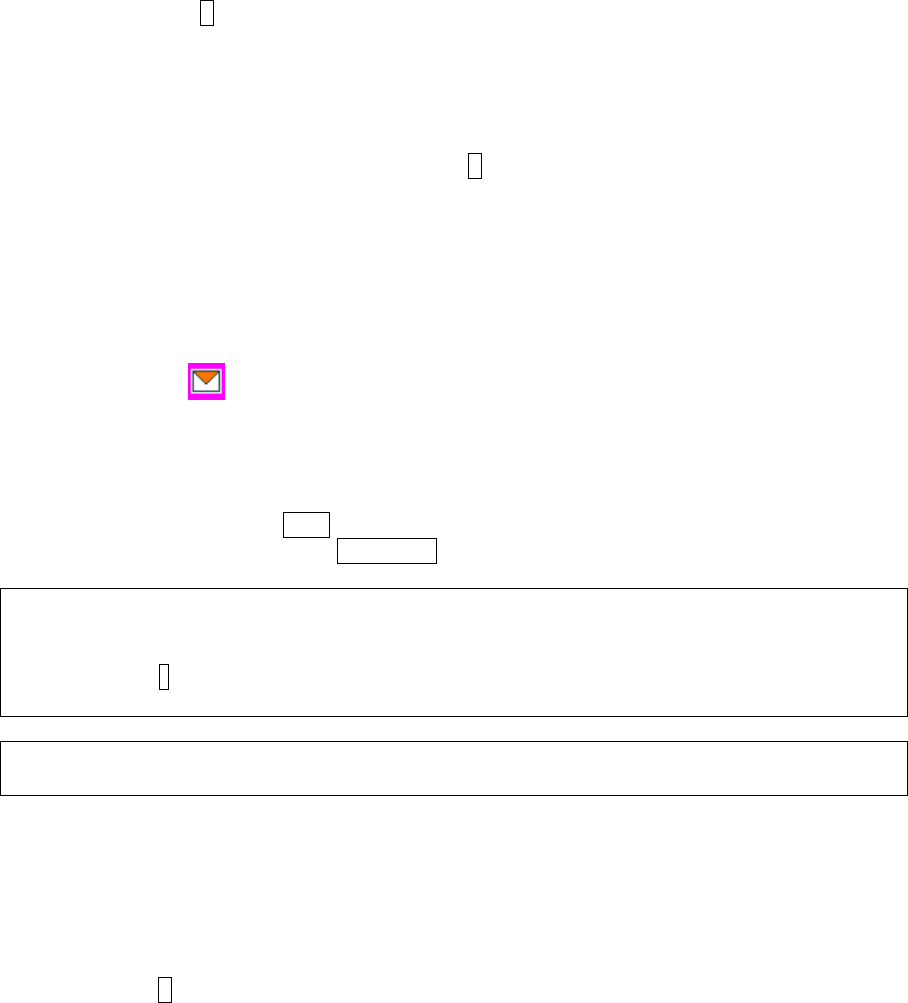
Using Voicemail
Setting Up Your Voicemail
All unanswered calls to your PCS Phone are automatically transferred to voicemail, even if your
phone is in use or turned off. Therefore, you will want to set up your PCS voicemail box and
personal greeting as soon as your PCS Phone is activated.
To set up voicemail:
1. Press and hold 1.
2. Follow the system prompts to:
• Create your pass code
• Record your greeting
• Record your name announcement
• Choose whether to activate One-Touch Message Access (a feature that lets you access
messages simply by pressing and holding 1, bypassing the need for you to enter your
passcode).
Voicemail Notification
There are several ways your PCS Phone alerts you:
• By displaying a message on the screen.
• By sounding the assigned ringer type.
• By the LED blinking red.
• By displaying at the top of your screen.
New Voicemail Message Alerts
When you receive a new voice message, your phone alerts you and prompts you to you’re your
voicemail.
To call your voicemail, press Talk .
To display your Missed Log, press MENU/OK >Missed Alerts.
Important: When you are roaming off the Nationwide PCS Network, you may not receive
notification of new voicemail messages. It is recommended that you periodically check your
voicemail by dialing 1 + area code + your PCS Phone Number. When your voicemail box
answers, press * and enter your pass code. You will be charged roaming rates when accessing
voicemail while roaming off the Nationwide PCS Network.
Note: Your phone accepts messages even when it is turned off. However, you are only notified
of new messages when your phone is turned on and you are in a PCS Service Area.
Retrieving Your Voicemail Messages
You can review your messages directly from your PCS Phone or from any other touch-tone
phone. To dial from your PCS Phone, you can either speed dial your voicemail box or use the
menu keys.
Using One-Touch Message Access:
Press and hold 1. (Your phone will dial your voicemail box.)
42

Using the Menu Keys on Your PCS Phone to Access Your Messages:
1. Press MENU/OK > Messaging > Voicemail.
2. Select Call Voicemail or Call:Speaker On.
Note: You are charged for airtime minutes when you are accessing your voicemail from your
PCS Phone.
Using a Phone Other Than Your PCS Phone to Access Your Messages:
1. Dial your PCS Phone Number.
2. When your voicemail answers, press *.
3. Enter your pass code.
Tip: When you call into voicemail you first hear the header information (date, time, and sender
information) for the message. To skip directly to the message, press 4 during the header.
Voicemail Options
Your PCS Phone offers several options for organizing and accessing your voicemail.
Using Expert Mode
Using the Expert mode setting for your personal voicemail box helps you navigate through the
voicemail system more quickly by shortening the voice prompts you hear at each level.
To turn Expert mode on or off:
1. Press and hold 1 to access your voicemail. (If your voicemail box contains any new or
saved messages, press * to access the main voicemail menu.)
2. Press 3 to change your Personal Options following the system prompts.
3. Press 3 for expert mode.
4. Press 1 to turn Expert mode on or off.
Setting Up Group Distribution Lists
Create up to 20 separate group lists, each with up to 20 customers.
1. Press and hold 1 to access your voicemail.
2. Press 3 to change your Personal Options following the system prompts.
3. Press 2 for Administrative Options.
4. Press 5 for Group Distribution Lists.
5. Follow the voice prompts to create, edit, rename or delete group lists.
PCS Callback
Return a call after listening to a message without disconnecting from voicemail.
• Press 8 after listening to a message. (Once the call is complete, you’re returned to the
voicemail main menu.)
Voicemail-to-Voicemail Message
Record and send a voice message to other PCS Voicemail customers.
1. From the main voicemail menu, press 2 to send a message.
2. Follow the voice prompts to enter the phone number.
43

3. Follow the voice prompts to record and send your voice message.
Voicemail-to-Voicemail Message Reply
Reply to a voice message received from any other PCS Voicemail customer.
1. After listening to a voice message, press 2.
2. Follow the voice prompts to record and send your reply.
Voicemail-to-Voicemail Message Forwarding
Forward a voice message, except those marked “Private,” to other PCS Voicemail customers.
1. After listening to a message, press 6.
2. Follow the voice prompts to enter the phone number.
3. Follow the voice prompts to record your introduction and forward the voice message.
Voicemail-to-Voicemail Receipt Request
Receive confirmation that your voice message has been listened to when you send, forward, or
reply to other PCS users.
1. After you have recorded a message, press 2 to listen to the recorded message.
2. Press 5 for More Options.
3. Press 3 to mark receipt requested.
4. Press 1 to send your voicemail message.
Extended Absence Greeting
When your phone is turned off or you are off the Nationwide PCS Network for an extended
period, this greeting can be played instead of your normal personal greeting.
1. From the main voicemail menu, press 3 for Personal Options.
2. Press 2 for Greetings.
3. Press 3 to record an Extended Absence Greeting.
Clearing the Message Icon
Your phone may temporarily continue to display the icon after you have checked your voice and
text messages.
To clear the icon from the display screen:
1. Select MENU/OK > Messaging > Voicemail > Clear Count.
2. Select Yes.
Using Caller ID
Caller ID allows people to identify a caller before answering the phone by displaying the number
of the incoming call. If you do not want your number displayed when you make a call, just follow
these easy steps.
To block your phone number from being displayed for a specific outgoing call:
1. Press * 6 7.
2. Enter the number you want to call.
3. Press TALK .
To permanently block your number, call PCS Customer center.
44
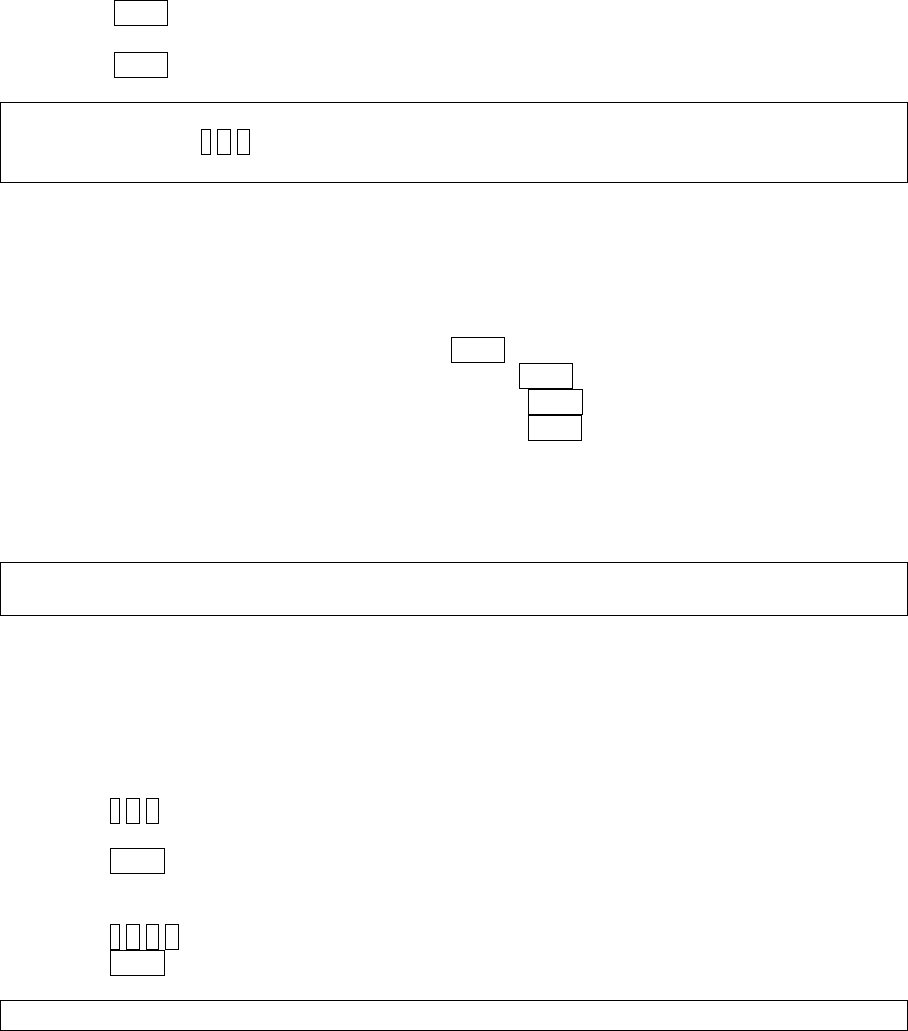
Responding to Call Waiting
Call Waiting alerts you to incoming calls while you’re on a call by sounding beeps. The display
screen informs you that a call is coming in and shows the caller’s phone number (if it is available
and you are in digital mode).
To respond to an incoming call while you’re on a call:
• Press TALK .( This puts the first caller on hold and answers the second call.)
To switch back to the first caller:
• Press TALK again.
Tip: For those call where you don’t want to be interrupted, you can temporarily disable Call
Waiting by pressing * 7 0 before placing your call. Call Waiting is automatically reactivated
once you end the call.
Making a Three-Way Call
With Three-Way Calling, you can talk to two people at the same time. When using this feature,
the normal airtime rates will be charged for each of the two calls.
To make a three-way call:
1. Enter a number you wish to call and press TALK.
2. Once you have established the connection, press TALK .
3. Dial the second number you wish to call and press TALK.
4. When you’re connected to the second party, press TALK again to begin your three-way
call.
If one of the people you called hangs up during your call, you and the remaining caller stay
connected. If you initiated the call and are the first to hang up, all three callers are disconnected.
Note: Call Waiting and Three-Way Calling may not be available while roaming off the PCS
Network.
Using Call Forwarding
Call Forwarding lets you forward all your incoming calls to another phone number – even when
your phone is turned off. You can continue to make calls from your phone with Call Forwarding
activated.
To Activate Call Forwarding
1. Press * 7 2.
2. Enter the area code and phone number to which your future calls should be forwarded.
3. Press TALK. You will hear a tone to confirm the activation of Call Forwarding.
To Deactivate Call Forwarding
1. Press * 7 2 0.
2. Press TALK. You will hear a tone to confirm the deactivation.
Note: You are charged a higher rate for calls you have forwarded.
45

Using SMS Text Messaging
With SMS Text Messaging, you can use a person’s wireless phone number to send instant text
messages from your PCS Phone to their messaging-ready phone - and they can send
messages to you. In addition, SMS Text Messaging includes a variety of pre-set messages,
such as “I’m running late, I’m on my way,” that make composing messages fast and easy.
New Messages
When you receive a voice message, a pop-up notification will automatically appear on your
phone’s main display screen. Use your softkeys to view the message.
Composing SMS Text Messaging
To compose an SMS Text message:
1. Select MENU/OK > Messaging > Send Message > Text and select the entry method you
prefer:
• Contacts to select a recipient from your internal Contacts. (Qualifying Contacts entries
must contain a phone number or an email address.)
• Phone# to use the keypad to enter the phone number of the person to whom you wish
to send a message.
• Email to enter the recipient’s email address.
2. Press MENU/OK to save the recipient. (You may include up to 50 recipients per message.)
3. Press Next (left softkey) when you have finished selecting and entering recipients.
4. Compose a message or use the preset messages or smileys (icons). To type a message,
use your keypad to enter your message. Select Mode(right softkey) to select a character
input mode.
5. Scroll down to select the message priority (Ordinary or Urgent), set the callback number,
set the signature, or set the delivery receipt.
6. Review your message and select Send(left softkey). (You may also select additional
messaging options by selecting Options [right softkey] to change the recipients or save to
draft.)
Displaying Messages
To display a Message from the main menu:
1. Press MENU/OK to access the main menu.
2. Select Messaging and press MENU/OK.
3. Select Text and press MENU/OK. (The folder list appears.)
4. Select Inbox, Sent Mail, Pending, Drafts, or your defined folder and press MENU/OK.
(The message list appears.)
5. Highlight the header of the message you want to see and press MENU/OK. (The message
detail appears.)
46

Safety
General Precautions
There are several simple guidelines to operating your phone properly and maintaining safe,
satisfactory service.
• To maximize performance, do not touch the bottom portion of your phone where the
internal antenna is located while using the phone.
• Try not to hold, bend, or twist the phone’s antenna.
• Don’t use the phone if the antenna is damaged.
• Speak directly into the mouthpiece.
• Avoid exposing your phone and accessories to rain or liquid spills. If your phone does get
wet, immediately turn the power off and remove the battery.
• Do not expose your phone to direct sunlight for extended periods of time (such as on the
dashboard of a car).
• Although your phone is quite sturdy, it is a complex piece of equipment and can be broken.
Avoid dropping, hitting, bending, or sitting on it.
• Any changes or modifications to your phone not expressly approved in this document could
void your warranty for this equipment and void your authority to operate this equipment.
Note: For the best care of your phone, only PCS-authorized personnel should service your
phone and accessories. Failure to do so may be dangerous and void your warranty.
Maintaining Safe Use of and Access to Your Phone
Do Not Rely on Your Phone for Emergency Calls
Mobile phones operate using radio signals, which cannot guarantee connection in all conditions.
Therefore you should never rely solely upon any mobile phone for essential communication
(e.g., medical emergencies). Emergency calls may not be possible on all cellular networks or
when certain network services and/or mobile phone features are in use. Check with your local
service provider for details.
Using Your Phone While Driving
Talking on your phone while driving (or operating the phone without a hands-free device) is
prohibited in some jurisdictions. Laws vary as to specific restrictions. Remember that safety
always comes first.
Following Safety Guidelines
To operate your phone safely and efficiently, always follow any special regulations in a given
area. Turn your phone off in areas where use is forbidden or when it may cause interference
or danger.
Using Your Phone Near Other Electronic Devices
Most modern electronic equipment is shielded from radiofrequency (RF) signals. However, RF
signals from wireless phones may affect inadequately shielded electronic equipment.
RF signals may affect improperly installed or inadequately shielded electronic operating
systems and/or entertainment systems in motor vehicles. Check with the manufacturer or their
47

representative to determine if these systems are adequately shielded from external RF signals.
Also check with the manufacturer regarding any equipment that has been added to your vehicle.
Consult the manufacturer of any personal medical devices, such as pacemakers and hearing
aids, to determine if they are adequately shielded from external RF signals.
Note: Always turn off the phone in health-care facilities and request permission before using the
phone near medical equipment.
Turning Off Your Phone Before Flying
Turn off your phone before boarding any aircraft. To prevent possible interference with aircraft
systems, the U.S. Federal Aviation Administration (FAA) regulations require you to have
permission from a crew member to use your phone while the plane is on the ground. To prevent
any risk of interference, FCC regulations prohibit using your phone while the plane is in the air.
Turning Off Your Phone in Dangerous Areas
To avoid interfering with blasting operations, turn your phone off when in a blasting area or in
other areas with signs indicating two-way radios should be turned off. Construction crews often
use remote-control RF devices to set off explosives.
Turn your phone off when you’re in any area that has a potentially explosive atmosphere.
Although it’s rare, your phone and accessories could generate sparks. Sparks can cause an
explosion or fire, resulting in bodily injury or even death. These areas are often, but not always,
clearly marked.
They include:
• Fueling areas such as gas stations.
• Below deck on boats.
• Fuel or chemical transfer or storage facilities.
• Areas where the air contains chemicals or particles such as grain, dust, or metal powders.
• Any other area where you would normally be advised to turn off your vehicle’s engine.
Note: Never transport or store flammable gas, flammable liquids, or explosives in the
compartment of your vehicle that contains your phone or accessories.
Restricting Children’s Access to Your Phone
Your phone is not a toy. Do not allow children to play with it as they could hurt themselves and
others, damage the phone or make calls that increase your phone bill.
Caring for the Battery
Protecting Your Battery
The guidelines listed below help you get the most out of your battery’s performance.
• In order to avoid damage, charge the battery only in temperatures that range from 32º F to
113º F (0º C to 45º C).
• Don’t use the battery charger in direct sunlight or in high humidity areas, such as the
bathroom.
• Never dispose of the battery by incineration.
• Keep the metal contacts on top of the battery clean.
48

• Don’t attempt to disassemble or short-circuit the battery.
• The battery may need recharging if it has not been used for a long period of time.
• It’s best to replace the battery when it no longer provides acceptable performance. It can be
recharged hundreds of times before it needs replacing.
• Don’t store the battery in high temperature areas for long periods of time. It’s best to follow
these storage rules:
Less than one month: - 4º F to 140º F (-20º C to 60º C)
More than one month: - 4º F to 113º F (-20º C to 45º C)
Disposal of Lithium Ion (Li-Ion) Batteries
Do not handle a damaged or leaking Li-Ion battery as you can be burned. For safe disposal
options of your Li-Ion batteries, contact your nearest PCS-authorized service center.
Special Note: Be sure to dispose of your battery properly. In some are as, the disposal of
batteries in household or business trash may be prohibited.
Radiofrequency (RF) Energy
Understanding How Your Phone Operates
Your phone is basically a radio transmitter and receiver. When it’s turned on, it receives and
transmits radiofrequency (RF) signals. When you use your phone, the system handling your call
controls the power level. This power can range from 0.006 watts to 0.2 watts in digital mode.
Knowing Radiofrequency Safety
The design of your Phone complies with updated NCRP standards described below.
In 1991–92, the Institute of Electrical and Electronics Engineers (IEEE) and the American
National Standards Institute (ANSI) joined in updating ANSI’s 1982 standard for safety levels
with respect to human exposure to RF signals. More than 120 scientists, engineers and
physicians from universities, government health agencies and industries developed this
updated standard after reviewing the available body of research. In 1993,the Federal
Communications Commission (FCC) adopted this updated standard in a regulation. In August
1996, the FCC adopted hybrid standard consisting of the existing ANSI/IEEE standard and the
guidelines published by the National Council of Radiation Protection and Measurements
(NCRP).
Body-Worn Operation
To maintain compliance with FCC RF exposure guidelines, if you wear a handset on your body,
use the PCS supplied or approved carrying case, holster or other body-worn accessory. If you
do not use a body-worn accessory, ensure the antenna is at least [2.4] centimeters from your
body when transmitting. Use of non-PSC approved accessories may violate FCC RF exposure
guidelines.
For more information about RF exposure, visit the FCC Web site at www.fcc.gov.
Specific Absorption Rate (SAR) for Wireless Phones
The SAR is a value that corresponds to the relative amount of RF energy absorbed in the head
of a user of a wireless handset.
49

The SAR value of a phone is the result of an extensive testing, measuring and calculation
process. It does not represent how much RF the phone emits. All phone models are tested at
their highest value in strict laboratory settings. But when in operation, the SAR of a phone can
be substantially less than the level reported to the FCC. This is because of a variety of factors
including its proximity to a base station antenna, phone design and other factors. What is
important to remember is that each phone meets strict federal guidelines. Variations in SARs do
not represent a variation in safety.
All phones must meet the federal standard, which incorporates a substantial margin of safety.
As stated above, variations in SAR values between different model phones do not mean
variations in safety. SAR values at or below the federal standard of 1.6 W/kg are considered
safe for use by the public.
The highest reported SAR values of the SCP-2500 are:
Cellular CDMA mode (Part 22): Head: [1.48] W/kg; Body-worn: [0.616] W/kg
PCS CDMA mode (Part 24): Head: [1.46] W/kg; Body-worn: [0.367] W/kg
FCC Radiofrequency Emission
This phone meets the FCC Radiofrequency Emission Guidelines. FCC ID number:
AEZSCP-25H. More information on the phone’s SAR can be found from the following FCC Web
site: http://www.fcc.gov/oet/fccid.
FCC Notice
This device complies with Part 15 of the FCC Rules. Operation is subject to the following two
conditions: (1) this device may not cause harmful interference, and (2) this device must accept
any interference received, including interference that may cause undesired operation.
Changes or modifications not expressly approved by the party responsible
for compliance could void the user’s authority to operate the equipment.
These limits are designed to provide reasonable protection against harmful interference in a
residential installation. This equipment generates, uses and can radiate radio frequency energy
and, if not installed and used in accordance with the instructions, may cause harmful
interference to radio communications.
However, there is no guarantee that interference will not occur in a particular installation.
If this equipment does cause harmful interference to radio or television reception, which can be
determined by turning the equipment off and on, the user is encouraged to try to correct the
interference by one or more of the following measures:
• Reorient the direction of the internal antenna.
• Increase the separation between the equipment and receiver.
• Connect the equipment into an outlet on a circuit different from that to which the receiver is
connected.
• Consult the dealer or an experienced radio/TV technician for help.
Note: This equipment has been tested and found to comply with the limits for a Class B digital
device, pursuant to Part 15 of the FCC Rules.
50
51